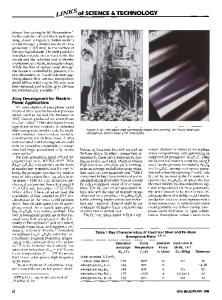Links of Science & Technology
- PDF / 5,444,824 Bytes
- 5 Pages / 576 x 777.6 pts Page_size
- 97 Downloads / 332 Views
& TECHNOLOGY
Rare-Earth Magnets J.D. Livingston Sixteen New Metals Whatever your specialty is in materials science, imagine how many years of new experiments you could plan if you suddenly learned that 16 new elements had been discovered. Materials scientists found themselves in a similar situation after World War II (even though they did not yet call themselves "materials scientists"). In their preface to the 1961 symposium report1 entitled The Rare Earths, editors F.H. Spedding and A.H. Daane wrote the following: "The availability in large volume of 16 new metals with rather distinctive new properties brought this book into being. We refer to the so-called rare earths and associated elements lanthanum, yttrium, and scandium, which total about one-fourth of our known metals. Here is a practically untapped source of unique metals. Elements such as cerium, lanthanum, neodymium, and yttrium are as abundant as lead and tin, and even the least common rare earths are more abundant than the platinumgroup metals and gold." Basic materials research in the 1950s and 1960s on these newly available metals led to the development of three generations of rare-earth magnets in the 1970s and 1980s. These magnets have found important application in a wide range of products, including motors and earphones, computers and printers, antilock brake systems, and magnetic-resonance imaging. The "so-called rare earths" ("socalled" because they are neither rare nor earths) referred to by Spedding and Daane are elements 58 through 71, the 14 4/ elements (of which only 13 are stable, prometheum being radioactive). Although most of these and the three chemically similar "associated" elements (La, Y, and Sc) were discovered in the nineteenth century, they were very difficult to separate. Prior to World War II, only a few were available in quantity, and they were not of high purity. I lowever one happy by-product of the Manhattan Project was improved separation f. methods for these elements. These meth•'• ods were commercialized soon after the war, making these "16 new metals" available in large quantities and high purity.
As used today, the term "rare earths" commonly includes the 4/elements plus La, Y, and, less frequently, Sc. The rare earths were of interest to the Manhattan Project largely because they were common fission products of uranium. Although these metals retain some applications in the nuclear industry, materials research in the 1950s and 1960s led to many other applications, the most notable of which being permanent magnets much more powerful than any previously known.
Early Magnetic Studies It was realized early that one of the most interesting physical properties of rare-earth metals was their high magnetic moments, resulting from unpaired 4/ electrons. Two rare earths—Dy and Ho—have the highest magnetic moment per unit volume of all the elements, more than 50% higher than that of iron. They and five other rare earths are ferromagnetic. That's the good news. The bad news is that their Curie temperatures are well below room t
Data Loading...











